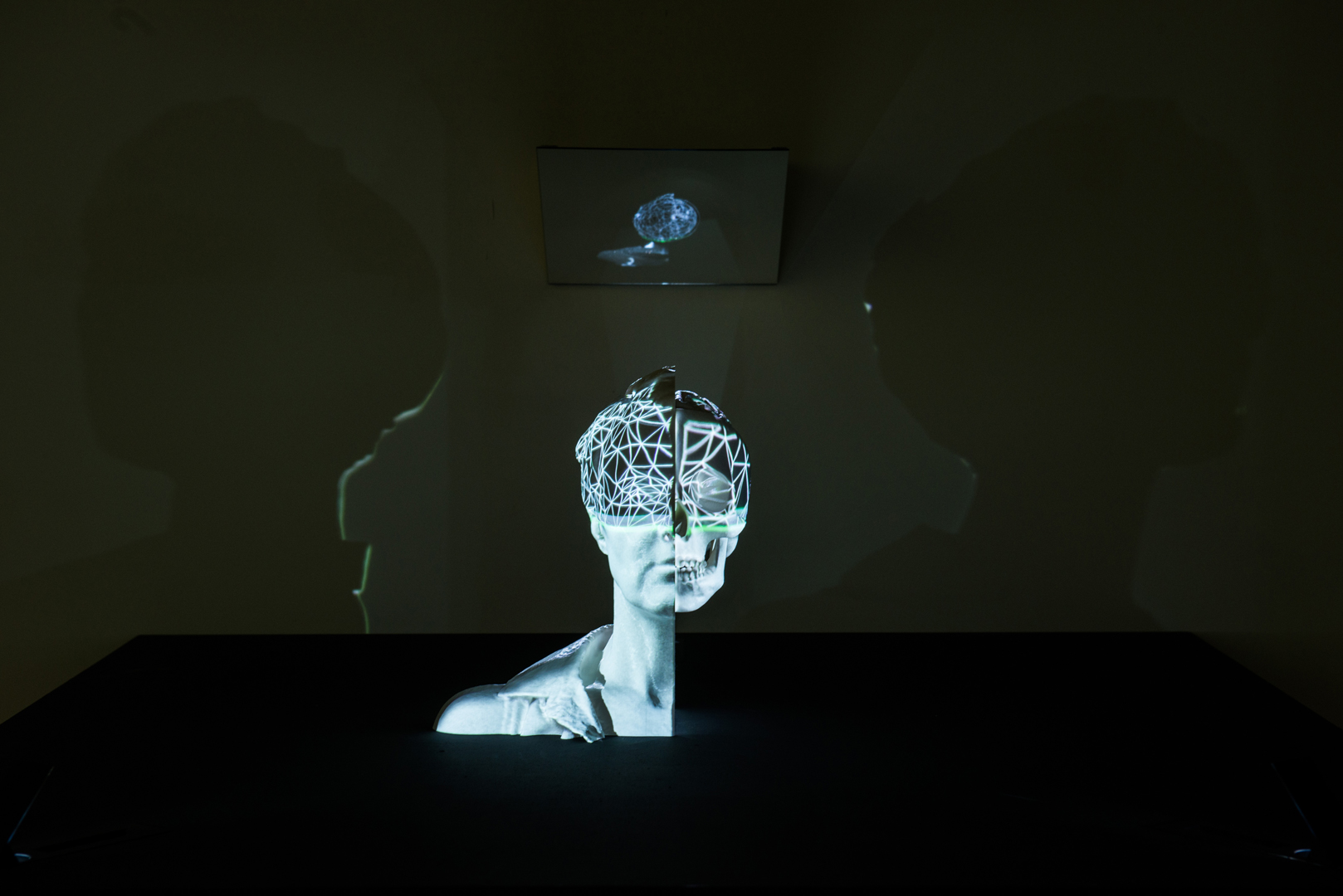“Neuro memento mori: a portrait of the artist contemplating death” by Jane Prophet
Title:
Artist(s) and People Involved:
Exhibiting Artist(s):
-
Jane Prophet
-
- University of Michigan
Symposium:
Venue(s):
Creation Year:
Medium:
Artist Statement:
In Neuro memento mori: a portrait of the artist contemplating death, digital animations and live action video are projection mapped onto a 3D print of the artist’s head and neck. The 3D printed bust is made from data from scanning, firstly using 3D facial scanning and, secondly, brain data gathered during novel MRI experiments, designed in collaboration with two neuroscientists. In these experiments the artist viewed memento mori paintings and meditated on death in the scanner. The life-sized 3D printed sculptures are dissected to reveal the artist’s brain and ‘make real’ fMRI data gathered during the experiments in the MRI scanner. Computation is used to produce 3D neuroimages, 3D prints and computer animations that are projection-mapped back onto the 3D object. The artworks, made with neuroscientists, are contemporary memento mori made from data. Carl Sagan’s quote reminds us to remember our small scale in relation to the universe and to live better, more compassionate lives, as a result. Memento mori and vanitas artworks, popular in the seventeenth century had a similar function.
They supposedly reminded each viewer of their mortality, prompting them to live better lives. Neuro memento mori is inspired by an object in the Wellcome Trust Permanent Collection, “Wax model of a Female head depicting life and death” (Unknown 1701-1800). It shows a woman’s bisected head, the left half apparently a detailed portrait of a living woman, open-eyed, with painted lips and blond hair arranged in ringlets. Her left hand frames her face while the right half of her head is shown in post mortem decay. Resting on her skeletonised right hand, her skull crawls with insects, maggots and worms. A snake emerges from her empty eye socket. This compelling object prompted me to question whether, as we look at memento mori artworks, we do ‘remember, we must die’.
What parts of our brain are active when we look at these artworks, and, when we contemplate death directly, without looking at memento mori art? Made in collaboration with neuroscientists Zoran Josipovic (NYU) and Andreas Roepstorrf (Aarhus University), I looked at representations of memento mori while in a MRI scanner that records my brain function. Following Josipovic’s instructions, I learned to meditate, to contemplate death, and repeated that meditation in the scanner. Neuroimages were processed to produce 3D data of my brain, to make 3D printed sculptural objects. The form of the life-sized portrait sculpture refers to the Wellcome Trust object, the artist’s head is dissected, revealing the skull and brain. Video and computer animations are then projection-mapped onto the sculpture to create a contemporary memento mori.
Discussions of Big Data have drawn attention to the acquisition and manipulation of personal data, including medical data such as neuroimages which provide huge amounts of quantifiable data, most of which is indeterminate to the non-expert. Scholars of media art and comparative literature have drawn attention to the collapse of boundaries between information and embodiment and the ways that bodies are co-constituted with data, or emerge with data (Paul 2011, Thacker 2003) It is common for such writing to take either utopian stance, described by Katherine Hayles as the wish, “to be raptured out of the bodies that matter in the lust for information,” (Hayles 2008) or conversely, a dystopian view. This work shows that there are porous boundaries, or entanglements, between nonhuman animal and human, between life and death. It uses the artist’s corporeal data as media for artistic expression to subvert the formation of subjects by Big Data. The work specifially addresses the porous boundaries between life and death, growth and decay.
Neuro memento mori: a portrait of the artist contemplating death is one of a series of works made over the last twenty years that emerge through interdisciplinary collaboration. To a greater or lesser extent these works each owe a debt to conversations and insights gained from rich collaborative partnerships with engineers, medical researchers, surgeons and scientists. In this case they key collaborative partners are from the field of neuroscience. The MRI experiments were designed by us as a group and then conducted at Aarhus University, lead by Andreas Roepstorrf, who is the Director of the Interacting Minds Centre; his colleague, Joshua Skewes, working closely with the artist on the experiment design. From New York University, Zoran Josipovic developed the meditation experiment design and trained the artist for a year to prepare her for the experiments.










